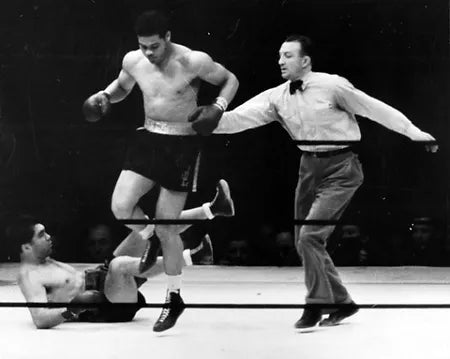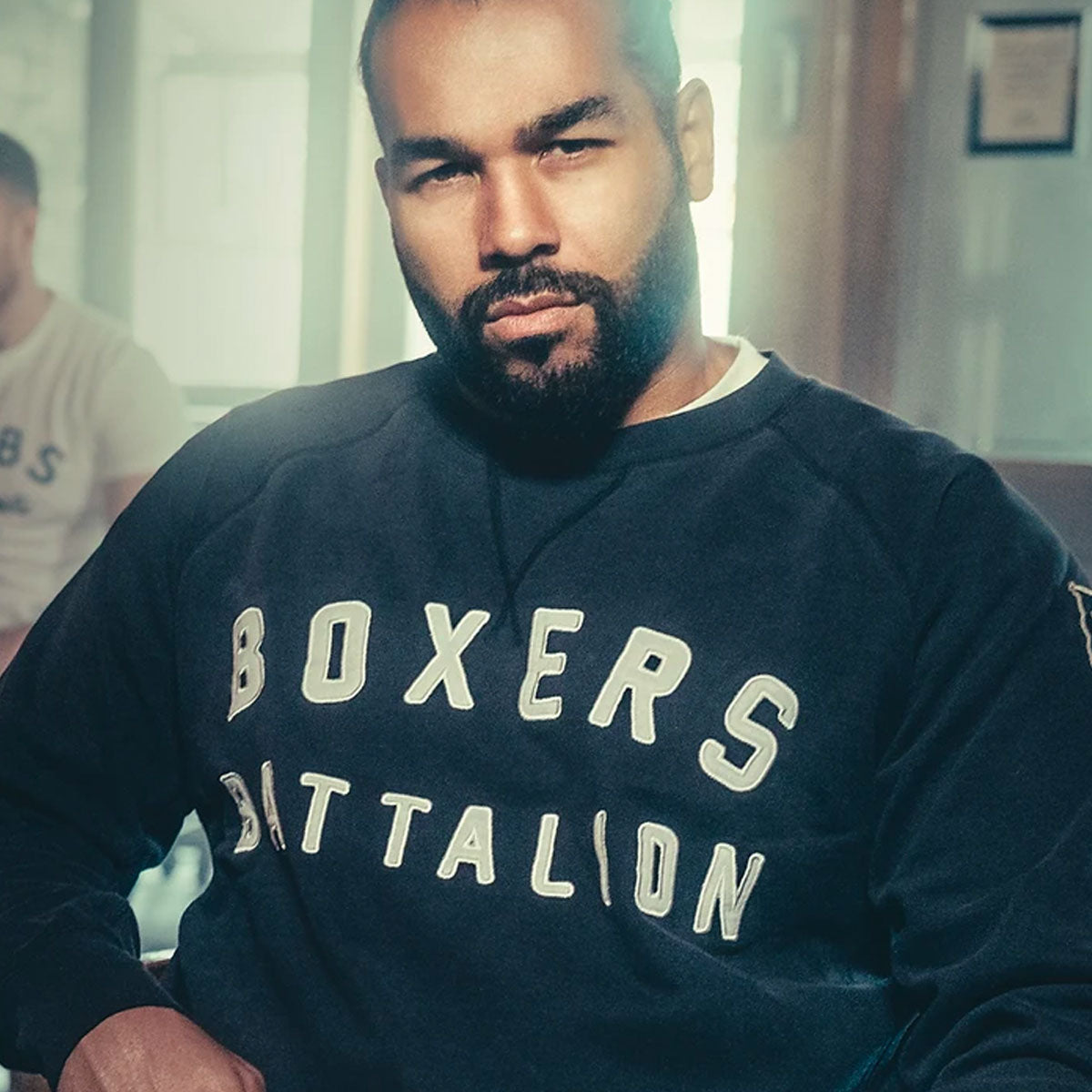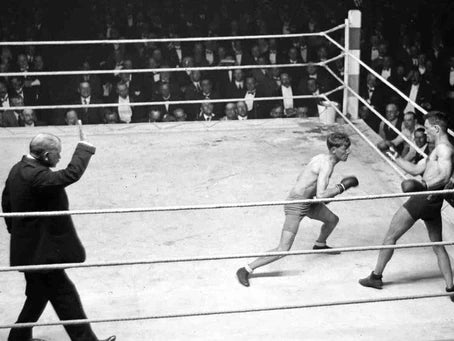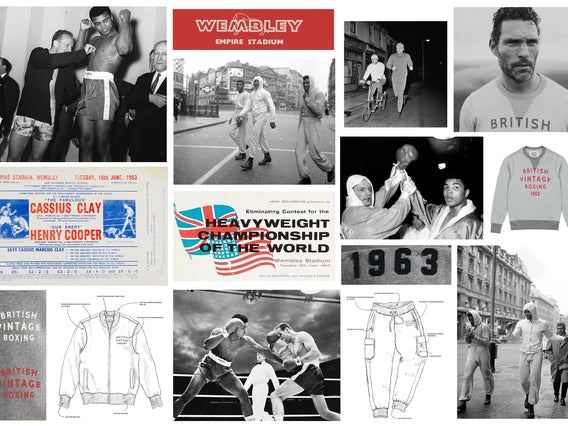By Paul Zanon
“Joe Louis is a credit to his race – the human race.”
Jimmy Cannon, Journalist
Twenty six consecutive heavyweight world title defences. Let that sink in. The record set by Joseph Louis Barrow over an uninterrupted 11 year reign, still holds to this very day and may take a number of decades, if not centuries before it’s overtaken. However, the man behind the gloves was far more than a pugilistic icon.
Born on 13 May 1914 in Lafayette, Alabama, Joe Louis, one of eight children grew up in meagre surroundings. His grandparents were slaves, his mother Lillie was a laundress and his father, Munroe Barrow, known as Mun, was a sharecropper - an age old cashless system which allowed a tenant to work the land, in return for a share of the crops. Unfortunately, Louis father suffered from mental illness and was sent to an asylum, never to return. Young Joe was two years old at the time. Mun passed away two years later.
Shortly after, Lillie re-married to a gentleman by the name of Patrick Brooks and the family relocated to north Detroit. Louis’s education was limited and as a young teenager he attended the Bronson Trade School learning the fundaments of cabinet making. As he started to interact with local gangs his mother decided that violin lessons would be a more productive distraction for him. However, around this time, one of Louis’s friends had introduced him to the art of boxing and his short lived, non-existent orchestral career disappeared in a heartbeat. Unbeknown to his mother, he used the violin lesson money to fund boxing training at the Brewster Recreation Centre. Packing his gloves in the violin case, Louis embarked on his amateur boxing career in 1932, fighting under the name of shortened name of Joe Louis, to throw his mother off the scent.
His debut was against Iowan born, light heavyweight Johnny Miler, who fought in the 1932 Olympics in Los Angeles. Despite hitting the canvas on several occasions and losing his maiden voyage, it soon became apparent that Louis could hit. Very hard. Over the next two years, the future sporting great clocked up an amateur sheet of 50 wins, four losses, including 43 victories by way of stoppage. He also won the Detroit Golden Gloves open class tournament at light heavyweight in 1933.
A lovely side note anecdote of a budding friendship between two of the greatest fighters of all time also happened around this time. Whilst walking to the gym one day, a ten year old kid walked along side Louis and asked, ‘Can I carry your bag for you?’ ‘Sure,’ replied Joe. This became a regular occurrence. Who was the kid from downtown Detroit? Non-other than Sugar Ray Robinson.
A few weeks after his twentieth birthday, on 4 July 1934 Louis made his professional debut, knocking out Jack Kracken in the opening round. In his first year, the sculptured six foot one and a half inch Detroit native fought 20 times, with 16 wins by way of stoppage. His twentieth fight certainly grabbed the media’s attention. 
Primo Carnera was the former world heavyweight champion from 1933-34, beating Jack Sharkey for the crown, defending it twice and then losing it to Max Baer. At the time of the Louis encounter, Carnera’s record was 82-7, he stood almost five inches taller and outweighed Louis by 65lbs. None of this mattered. Louis, in destructive form, smashed The Ambling Alp in six rounds, in front of an impressive 60,000 strong crowd. The New York Times stated, ‘Carnera visited the canvas three times before becoming ‘utterly helpless, clinging to the top rope.’
Louis vs Carnera
Many saw the Carnera win as a victory over fascist dictator, Benito Mussolini and all he stood for. As World War II approached and the political propaganda machine was being ramped up, Louis did his best to stick to his boxing and continued to clock up victories over well respected former champions, gaining a reputation for packing venom in his punches, whilst striking with frightening accuracy.
Six weeks after disposing of Carnera, Louis smashed King Levinsky inside a round, before taking on Max Baer, on 24 September 1935 at Yankee Stadium. Up to this point, Baer had only ever been knocked down once before, against Frankie Campbell, but picked himself up off the canvas and stopped Campbell in the fifth round. However, this time, there would be no second chance. Louis’s punches were far less forgiving and Baer was knocked out in the fourth round. Three months later, Louis knocked out Spaniard Paulino Uzcudun in the fourth round, inflicting his first and only ever stoppage loss in a 69 fight career. Unsurprisingly, Louis, now the world heavyweight No.1 contender, was awarded Athlete of The Year, 1935, by the Associated Press.
The next former world champion to challenge Joe Louis unbeaten streak, was Max Schmeling. The German was almost a decade older, had been boxing since 1924 and had already fought 53 times before Louis had even turned professional. He’d also incurred five losses, including a tenth round stoppage against Max Baer. Although he’d held the title from 1930-32, he was now considered to be over the hill by many. This was widely regarded as a sensible tune up fight for the undefeated Louis en-route to gaining his crown.
As the looming World War grew ever closer, both fighters were to an extent pawns in one of the most high octane games of chess ever to take place on planet earth. As Germany was being influenced by one of the world’s most vile dictators, creating a foundation for Nazi ideology, America was pushing their paragon of democracy. When both fighters entered the ring, losing was not an option, due to the wider reaching consequences. 
Louis vs Schmeling 1
On 19 June 1936, the pair met at the Yankee Stadium. At the press conference, Schmeling said that he ‘Saw something,’ in Louis; referring to a weakness. Every time Louis threw his left jab, he would return his hand low, exposing his jaw. Schmeling’s training revolved around countering that window of opportunity by throwing an overhand right over Louis’s jab the moment it was thrown. The strategy worked to say the least, as the Michigan resident was floored in the fourth and ninth rounds, before Schmeling finished the job in the twelfth. The Brown Bomber was no longer undefeated. The Ring rated it as their Fight of The Year for 1936.
Schmeling should have now been fighting the champion, Jim Braddock, but due to management, political and promotional skulduggery, Schmeling was side lined. The fear was that if Schmeling won the strap, Louis would never get the chance to fight for the title as the Nazis would create a roadblock of sorts.
Bouncing back with gusto, two months later Louis knocked out former world champion Jack Sharkey, in three rounds, then added a further six crushing wins to his record, before finally meeting Braddock on 22 June 1937 at Comiskey Park, Chicago for the world heavyweight title. Braddock’s record boasted 51 wins at that point, but also 25 defeats and seven draws. Not a journeyman, but certainly not the resume of a champion looking to reign supreme. 
Louis v Sharkey
From the opening bell Louis went toe to toe with the New Jersey resident, looking for the knockout. As they started trading blows, it was Louis who fell victim to a short right counter from Braddock which put him on the canvas. It was a genuinely hurtful shot. Thankfully, Louis rode the storm, fought back with every tool he possessed and knocked out Braddock in the eighth session. This was the start of a historical run of title defences.
Louis vs Braddock
In dethroning Braddock, Louis became the first black man in 22 years, since Jack Johnson, to become heavyweight champion of the world, however, he didn’t become the richest. When Louis fought Braddock, he signed a contract that gave him ten percent of his earnings for the next ten years. The Cinderalla Man was a true tale of rags to riches, whereas Louis was unknowingly working his way through the gears of an inverted model over his coming years.
Two months into his reign, Louis took on The Tonypandy Terror, Tommy Farr. The hardened Welshman’s record was 71-25-19 at the time, but he’d never been in with opposition like Louis before. It was expected to be an early night for the champion, but Farr had other ideas, making Louis work every minute of the 15 rounds. Despite not getting the nod from the judges, he went back to Wales a hero.
Louis vs Farr
The focus for Louis now was the Schmeling rematch. Until he avenged that loss, he wouldn’t be satisfied. On 22 June 1938, Louis took his second chance by the throat in front of over 70,000 fans at Yankee Stadium. This time Schmeling didn’t get the opportunity to exercise any strategy. Coming out in frightening form, Louis dispatched of his opponent in just over two minutes of the opening session. The German spent the next ten days in hospital, recovering from cracked vertebrae in his back.
Louis vs Schmeling 2
By the virtue of the win, Louis became an iconic symbol of America, whilst Schmeling received a very frosty welcome from Hitler and his band of fascists. It was no secret that Schmeling detested Hitler’s polarised views on Jews and on a number of occasions had hidden Jews in his apartment to save them from the Nazis. In 1975, Schmeling said, “Looking back, I’m almost happy I lost that fight. Just imagine if I would have come back to Germany with a victory. I had nothing to do with the Nazis, but they would have given me a medal. After the war I might have been considered a war criminal.” (usatoday.com)
On 2 July 1939, two months before WWII kicked off, Schmeling beat Adolf Heuser in the first round, to become the German and European heavyweight champion. Schmeling saw active service in the War and suffered injuries, including shrapnel to his leg in the Battle of Crete in 1941. He hated war and everything Hitler stood for and when he had the chance, visited prisoner of war camps to assist in any way possible.
Germany on the other hand stripped Schmeling of everything he owned. With very few Deutschemarks to his name, he decided to fight again, fighting five times from 1947-48. However, at the age of 45, he realised it was not a long term plan and hung up the gloves for good in October 1948. While trying to work out what to do with his life and how to provide for his family, Schmeling, ironically, was approached by an American company. Coca-Cola, no less. They wanted him to be the brand ambassador for Europe and let’s just say the rest is history. He became an extremely wealthy man over the following decades and remained active with Coca-Cola into his nineties. In terms of his relationship with Louis, they remained close lifelong friends.
While Schmeling’s boxing career faded and his financial backbone strengthened, Louis was making history in the ring whilst unknowingly creating a vacuum of debt which would bite him down to the line. 
Louis vs Lewis
Seven months after the Schmeling rematch, Louis knocked out LL Cool J’s uncle, John Henry Lewis, in the first round. In his next dozen fights, nobody lasted the distance with the Brown Bomber, which included the likes of ‘Two Ton’ Tony Galento and the boxing brother of Max Baer, Buddy. However, on 18 June 1941, Louis run of walkovers came to an end as he encountered Billy Conn.
‘The Pittsburgh Kid’ started his career at 135lbs, only two weeks after Louis’s debut and slowly grew into his natural light heavyweight shell within five years, to capture 175lbs world honours. On the night they fought, Conn weighed in at 174lbs. A blown up super middleweight in today’s classification. Louis on the other hand weighed in at 200lbs and openly admitted he took the fight lightly, assuming he could blow the lighter man out of the water. This almost turned out to be his downfall.
In front of over 54,000 spectators at the Polo Grounds, New York, Louis set out to make his eighteenth defence of his title. Conn, albeit the same height as Louis, possessed far greater footwork, was illusive like a ghost and had an incredible toolkit of technical ability. By the end of the twelfth session, he was drawn on one scorecard and comfortably ahead on the other two. Then came his downfall. After boxing beautifully for the whole fight, he decided to get in close and try to knock out a lethargic Louis in the thirteenth round. The plan backfired and Louis connected with two crunching right hands, sealing the deal with two seconds left in the round.
In 1942, Louis enlisted as a private in the U.S. Army at Camp Upton, Long Island and shortly after moved to a cavalry unit in Fort Riley, Kansas. He continued to defend his title and donated an estimated $100,000 to the Army and Navy relief societies, which included his purses for defending his title against Buddy Baer and Abe Simon. He also took part in nearly 100 exhibitions. Unfortunately, The Brown Bomber’s philanthropic efforts would be his demise.
Despite experiencing a tirade of racism, Louis continued to proudly serve his country alongside fellow elite black athletes such as baseball legend Jackie Robinson and Sugar Ray Robinson. By 1945 he reached the rank of technical sergeant and although he was never deployed into a combat region, his efforts in energising and encouraging officers within the forces, not to mention his weight behind the recruitment drive to attain new soldiers, was immense. He was rightly awarded the decoration of Legion of Merit.
Louis’s first fight after the war was rematching Billy Conn on 19 June 1946. By this stage, Conn was a shell of the fighter from 1941 and Louis smashed him in eight rounds. By now, his debt was his toughest opponent. A combination of the IRS chasing up unpaid tax from the exhibitions and more damaging, his promoter, Mike Jacobs claiming Louis owed him an estimated $250,000. Despite earning a $600,000 purse for the Conn fight, his share after paying his shark infested waters, including his ex-wife and manager (which equated to over $200,000 alone), plus the taxman, Louis was left with enough to simply help deflect his debt.
After demolishing Tami Mauriello in the first round, on 5 December 1947 at Yankee Stadium, Louis took on Arnold Raymond Cream, better known as Jersey Joe Walcott. Despite a record of 42-13-1 at the time, Walcott was as tough as they came. He knocked Louis down in the first and fourth rounds and ground out a very respectable split decision loss. Inevitably, they rematched.
On 25 June 1948, Walcott, who had knocked down Louis in the third round, was ahead on the scorecards going into the eleventh round, when Louis did what he did best and flipped the script. After unleashing a left uppercut and right hook to the head, Walcott was in trouble. Louis, sensing his opponent was hurt followed up with a hurtful barrage, which sent Walcott to the canvas in a crumbled state.
A few months after the Walcott knockout, Louis officially retired. One day, whilst on the golf course, a member of the IRS turned up, presenting the champ with a tax bill of over $1million dollars. Despite earning nearly $5million in his career, between excessive spending, trusting his ill advising manager Mike Jacobs and being unaware that the exhibition bouts carried tax liability, the net $800,000 had gained from his career, has been wildly overtaken by his debt. In addition, the IRS had been adding extortionate interest to the outstanding bill. The champ was now officially broke.
Louis returned to the ring with the intention of regaining his title and some form of financial traction. Unfortunately, despite winning eight of his ten fights over the next 13 months, the two he lost were the most important. His comeback fight against the new champion, The Cincinnati Cobra, Ezzard Charles, showed the 218lbs, 36 year old Louis to be sluggish. His reflexes had naturally eroded, even though he still possessed devastating power. Charles heavily outpointed Louis and became the only man to ever last the 15 round distance and beat the former champion.
After a string of eight wins, including knocking out Lee Savold in six rounds, Louis took on rising contender, the Brockton Blockbuster, Rocky Marciano. Louis entered the fight the betting favourite, but the reality was, the fight should have never happened. Marciano was a concussive puncher and simply didn’t want to fight Louis, because he was his idol. 
Louis vs Marciano
Despite towering four inches over Marciano and outweighing him by 30lbs, the old lion was no match for the young gun. The eighth round knockout was savage. No other way of describing it. Seeing Louis knocked out through the ropes was disturbing for everyone. Marciano cried in his changing room and after the fight went to visit Louis in hospital. On discovering he was in a general ward, he approached the doctors and expressed how disgusted he was that Louis had not being given a private room. Marciano paid for Louis to be moved to private quarters and ensured he left hospital without incurring any medical debt from that fight. Louis hung up the gloves for good this time, with an incredible record of 66-3. The ‘incredible’ doesn’t come from the numbers, but from the content which made those numbers.
Still in dire financial straits, Louis certainly made a concerted effort to pull himself out of the red. After his departure from boxing, he wrestled for a few years and also refereed a number of bouts, including Joe Frazier versus Jerry Quarry in 1974 at Caesars Palace. He also invested into a long list of businesses, including a restaurant, a horse farm, insurance company and even went into partnership with his former rival Billy Conn, opening the Joe Louis Food Franchise in 1969. Unfortunately, he had the inverted midas touch and each business failed.
One of the few consistent incomes he was able to generate was working as a greeter at Caesars palace Las Vegas, where he would also blow most of his income on gambling, hoping for that one defining win to pull him out of the financial rut. A number of people assisted him with money through these tough times, including Jack Dempsey, mobster Frank Lucas and Max Schmeling.
After retirement, Louis struggled with drink and drugs. The lifestyle inevitably affected him and from the late 1960’s, right through the 70’s, Louis was in and out of hospital. He suffered mental and physical conditions, including strokes, heart issues and anxiety. In 1977 he was fitted with a pacemaker and spent the majority of his remaining years in a wheelchair. Thankfully, his circle of friends was wide and loving, and many came to his financial aid, including of course, Max Schmeling who paid for Louis’s hospital expenses on a number of occasions.
On 11 April 1981, Louis attended the Larry Holmes versus Trevor Berbick contest at Caesars Palace, then the following morning at 9:30am on 12 April, at only 66 years of age, arguably the best heavyweight of all time passed away from a heart attack at his home.
Sammy Davis Jr sang at the funeral, Frank Sinatra spoke and pallbearers including Muhammad Ali, Larry Holmes and his old friend, Max Schmeling, who covered the bulk of the funeral costs. His German friend and foe died in 2005, a few months shy of his one hundredth birthday.
Thanks to an exception from the president of the United States, Ronald Reagan, Louis was granted a pardon and was buried with full military honours at Arlington National Cemetery. The gravestone says – ‘LOUIS. The Brown Bomber. World Heavyweight Champion – 1937-1949.’
Joseph Louis Barrow’s presence can still be felt at Caesars Palace hotel in Las Vegas, where a statue of him stands and if you miss that one, a 24 foot high statue in downtown Detroit stands proud for all to see.
Inducted into The Ring Magazine Hall of Fame in 1954 and the International Boxing Hall of Fame in 1990, Louis was one of the most humble and polite sportsman ever to lace up a pair of gloves. In a 17 year career void from trash talk, after an incomparable heavyweight winning streak, it’s safe to say he let his fists do the talking. In the words of the champ, ‘I did the best I could with what I had.’
Paul Zanon, has had 11 books published, with almost all of them reaching the No1 Bestselling spot in their respective categories on Amazon. He has co-hosted boxing shows on Talk Sport, been a pundit on London Live, Boxnation and has contributed to a number of boxing publications, including, Boxing Monthly, The Ring, Daily Sport, Boxing News, Boxing Social, amongst other publications.






